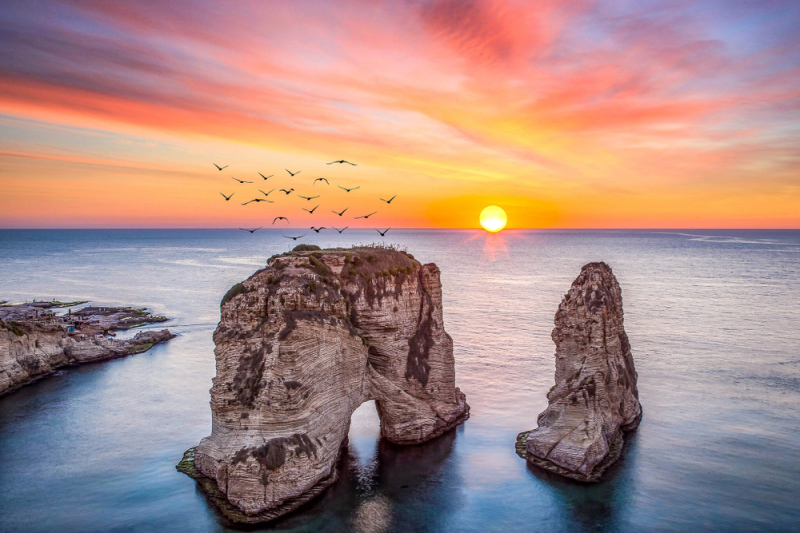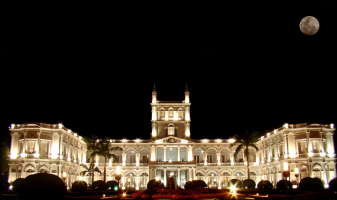Top 8 Best Places to Visit in Lebanon
Traveling to Lebanon provides an excellent opportunity to witness the blending of various religions. Despite the fact that Lebanon is mainly Muslim, more than ... read more...40% of the Lebanese population is Christian. Despite its tiny size, Lebanon has steadily risen at the top of many travelers' wish lists. Its location in the center of the Middle East and on the Mediterranean coast makes it a fascinating destination for all types of visitors. Some of the top sites to visit in Lebanon include Roman ruins, monasteries, hipster cafés, amazing restaurants and wineries, and lovely beaches. This list would be endless if Lebanon, the "Paris of the Middle East," were given enough time to explore all of its treasures.
-
The Jeita Grotto is a must-see for all visitors to Lebanon. You can not say you have been to Lebanon unless you have seen this grotto in Jeita, a village just outside of Beirut, Lebanon's capital. The Jeita Grotto, a cultural and historical landmark, was discovered in 1836 by Reverend William Thomson. It was destroyed in 1978 during the Lebanese Civil War and reopened in 1995. Despite this, the natural rock formations of the Jeita Grotto have been preserved. With its naturally formed stalagmites and stalactites lining the vast cave, the grotto is enchanting.
The Jeita Grotto is quite easy to find because it is a popular tourist and local attraction. The tour begins at the main entrance, which is accessible via cable car. Because the Jeita Grotto is divided into two portions (upper and lower), you can explore the bottom section by boat to visit the higher section. Take aware, however, that the use of cameras is strictly prohibited on the premises.
Location: Jeita, Mount Lebanon Governorate, Lebanon
Opening Hours: Daily, except Mondays, from 9:00 a.m. to 5:00 p.mEntrance fee:
- Children: $6.6
- Adults: $11.9

https://www.instagram.com/thankyoulebanon/ 
https://www.instagram.com/panoramaglobal1/ -
The Baatara Gorge Waterfall near Tannourine, discovered in 1952, is another must-see in Lebanon. It is regarded as one of the world's most stunning waterfalls. The Baatara Gorge Cascade boasts natural rock formations that geologists say were constructed millions of years ago, in addition to the stunning waterfall and its cooling waters where you may take a bath. It is also known as the "Three Bridges Chasm" because of the three bridges that dangle above the limestone cave, which is said to have existed when dinosaurs were still alive. Hikers and tourists flock to the Baatara Gorge Waterfall today to photograph the stunning Lebanese beauty.
The waterfall cascades 255 meters into the Balaa Pothole on the Lebanon Mountain Trail, a Jurassic limestone cave. The Three Bridges Chasm is a five-minute excursion into the valley below, where three natural bridges rise one over the other, overhanging a chasm falling towards Mount Lebanon, as one travels from Laklouk to Tannourine. During the spring thaw, a 90–100-meter cascade cascades down behind the three bridges and into the 240-meter chasm.
Location: Tannourine El Faouqa, North Governorate, Lebanon
Opening Hours: Daily (best time to visit is in the morning)
Entrance fee: free
https://www.instagram.com/naturalisticpage/ 
https://www.instagram.com/christhaotrinh/ -
Byblos is a city in Lebanon's Keserwan-Jbeil Governorate, often known as Jubayl or Jebeil. It is thought to have been inhabited for the first time between 8800 and 7000 BC and has been continuously inhabited since 5000 BC, making it one of the world's oldest continuously inhabited cities. Byblos was a part of many civilizations throughout its history, including Egyptian, Phoenician, Assyrian, Persian, Hellenistic, Roman, Fatimid, Genoese, Mamluk, and Ottoman.
Anyone who has studied world history knows that Lebanon is littered with ancient structures that attest to the existence of ancient human civilization. If you are a traveler who enjoys visiting historical sites, go to Byblos, Lebanon, which is a UNESCO World Heritage Site. Byblos is the country's oldest continually inhabited city, and some historians believe it is the world's oldest as well. Journey the Byblos Citadel to begin your visit to Byblos, explore the nooks and crannies inside, and learn about the city's history. After that, you can visit the Old Souk to buy some souvenirs to take home with you before heading to the Fish Fossil Museum. The Citadel costs $15 to enter, and the Fish Fossil Museum costs between $1.3 and $5.3.
Location: Byblos, Lebanon
Opening Hours: DailyEntrance fee: $15 to $20

https://wsimag.com/ 
https://www.gpsmycity.com/ -
Baalbek is a city in Lebanon's Beqaa Valley, about 67 kilometers northeast of Beirut, located east of the Litani River. It is the capital of the Governorate of Baalbek-Hermel. Baalbek was also known as Heliopolis in Greek and Roman eras. Baalbek had an estimated population of 82,608 people in 1998, the majority of whom were Shia Muslims, followed by Sunni Muslims and Christians.
Baalbek is the ideal location in Lebanon to visit if you want to view old archaeological sites. Baalbek, known as the "City of Sun," is home to the temples of Jupiter and Bacchus, among others. You may marvel at historic architecture in Baalbek, which served as a haven for ancient Romans as they tried to please and worship the gods. The Baalbek temples are close to the Syrian border, but this is not a cause for concern because the area is guarded by armed guards and is encircled by mountains that separate Syria from Baalbek. After that, you can visit the Old Souk to buy some souvenirs to take home with you before heading to the Fish Fossil Museum. The Citadel costs $15 to enter, and the Fish Fossil Museum costs between $1.3 and $5.3.
Location: Baalbek District, Beqaa Governorate, Lebanon
Opening Hours: DailyEntrance fee: $20 per hour

https://www.britannica.com/ 
https://vici.org/ -
Hamra Street, one of Beirut's main streets, is studded with cafés, restaurants, theaters, and universities. You may learn about the Lebanese "Champs-Elysées" on Hamra Street. The American University of Beirut and the Lebanese American University are two of the most prestigious universities along this route. Furthermore, the Hamra Streets Festival, which takes place every autumn, is held on the street. The Hamra Streets Festival is a cultural event that strives to showcase Lebanon's artistic and cultural variety. During the festival, there are adorned floats, carnival parades, dances, concerts, street art exhibits, and fireworks displays.
There are many western chains (such as Gloria Jean's, Caribou Coffee, Costa Coffee, and Starbucks), as well as many local shops and restaurants, in this area. Cafe Hamra, as the name suggests, is a restaurant that honors the historic street with vintage street graffiti art, a wide range of international and Lebanese cuisine, and hookah smoking. Cafe Younes is another prominent cafe that first opened in 1935 and is maintained by Amin Younes, the grandson of the same-named founder. It is also well-known for its tourist appeal and wide range of accommodations. The Crowne Plaza is the city's most well-known landmark.
Location: Rue 31, Hamra, Beirut, Mount Lebanon Governorate, Lebanon
Opening Hours: DailyEntrance fee: free

https://www.tripadvisor.com.vn/ 
https://www.flickr.com/ -
Our Lady of Lebanon, a Marian shrine in Lebanon, is a famous pilgrimage destination. The church sits near Harissa, a hilly community in Beirut's northwestern outskirts. It is owned by the Maronite Church in Lebanon and has a feast day on the first Sunday in May. The Statue of Our Lady of Lebanon is a 13-ton bronze statue of the Virgin Mary constructed in France and painted white. It was built in 1907 to worship Our Lady of Lebanon on top of a hill 650 meters above sea level in the hamlet of Harissa, 20 kilometers north of Beirut. Yousef Khazen generously gave the land. It was built in seven pieces on top of a stone base with a bottom perimeter of 64 meters, an upper perimeter of 12 meters, and an overall height of 20 meters. The statue stands 8.50 meters tall and has a diameter of 5.50 meters. The shrine and statue were dedicated in 1908, and it has since become a popular pilgrimage site.
It is one of the most important shrines dedicated to Mary, the Mother of Jesus, in the world. Millions of Christians and Muslims from all over the world visit the Shrine of Our Lady of Lebanon.
Location: Daraaoun, Harissa, Lebanon
Opening Hours: DailyEntrance fee: free

https://www.instagram.com/mondanite/ 
https://www.instagram.com/dndtravelsandtours/ -
In Lebanon, the Raouchè Pigeon Rocks are one of the country's natural wonders. The Raouchè Pigeon Rocks are a magnificent group of rocks that greet visitors as they arrive in Lebanon's capital city. While strolling along the corniche, visitors to the rocks can admire the sea and the rocks. At the Raouchè Pigeon Rocks, visitors will be treated to a beautiful sunset. Raouché is also said to be the bones of a sea monster that Perseus, the Greek hero, slaughtered in order to save Andromeda. Perseus put Medusa's head on the monster to convert it into stone, hence the stone is rock.
According to some historians, the word "raouché" comes from the Aramaic word rosh or the Arabic word ras, both of which mean "head." Others claim that it is a misspelling of the French word roche (rocher), which means rock. The AUB Archaeological Museum has flints and rudimentary stone tools found on the coasts near Raouché, which represent the area's oldest evidence of human presence.
Location: Raouche, Beirut, Lebanon
Opening Hours: DailyEntrance fee: free

https://www.travelhk.com/ 
https://www.crushpixel.com/ -
Lake Qaraoun is an artificial lake or reservoir located in Lebanon's Beqaa Valley's southern section. It was built at Qaraoun village in 1959 by constructing a 61 m concrete-faced rockfill dam in the middle reaches of the Litani River (the largest dam in Lebanon) (longest river in Lebanon). The reservoir has been utilized to generate hydropower, provide domestic water, and irrigate 27,500 acres of land.
The lake is home to 20,000 migrating birds who come to visit each year. The reservoir's catchment has a continental climate, with 90 percent of rainfall falling between November and April, with January seeing the most precipitation. At elevations above 1,500 m, snowfall is common.
Woodlands, orchards, and low-growing brush make up the vegetation on the lake's periphery. There has been no submerged or emergent vegetation observed in the lake during water-level variations as the stored water is used for numerous useful purposes. When the lake's water level is lowest, a steppe-like land slope with little vegetation of stony shingle terrain has been noted, with flocks of larks and lapwings.
Location: Lake Qaraoun, Lebanon
Entrance fee: free
Opening Hours: Daily
https://www.instagram.com/embassyoflebanonuk/ 
https://www.instagram.com/lebanontraveler/





























